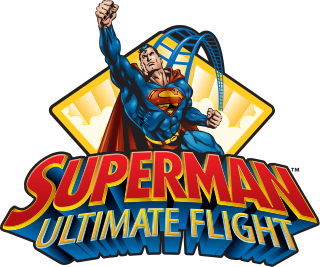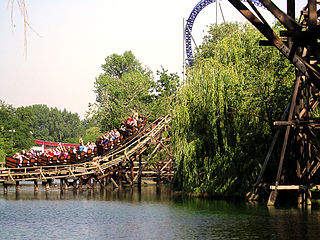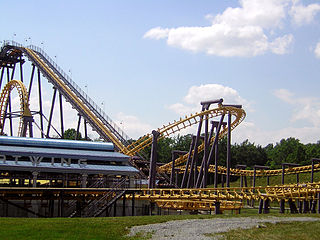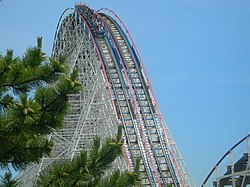
The Beast is a wooden roller coaster located at Kings Island amusement park in Mason, Ohio. Designed and manufactured in-house for approximately $3 million, the ride opened in 1979 as the tallest, fastest, and longest wooden roller coaster in the world. Decades later, it is still the longest, spanning 7,361 feet across 35 acres (14 ha) of hilly terrain. Two lift hills contribute to the ride's duration of more than four minutes, which also ranks as one of the longest among roller coasters. A refurbishment in 2022 increased the angle of the first drop and lengthened the ride by 2 feet (0.61 m).

The Big One, formerly known as the Pepsi Max Big One, is a steel roller coaster located at Pleasure Beach Resort in Blackpool, Lancashire, England. Designed by Ron Toomer and manufactured by Arrow Dynamics, the ride opened to the public on 28 May 1994 as the tallest and steepest roller coaster in the world, featuring a height of 213 feet (65 m) and a drop angle of 65 degrees. It held the title as the tallest until 1996 when Fujiyama opened in Japan. Construction of the ride cost £12 million. The ride was sponsored by Pepsi until 2011, at which time Pepsi Max was removed from the name.

El Toro is a wooden roller coaster located at Six Flags Great Adventure in Jackson Township, New Jersey. Designed by Werner Stengel and manufactured by Intamin, the ride opened to the public on June 11, 2006. Intamin subcontracted Rocky Mountain Construction to build the ride, and the coaster's track was prefabricated, allowing for quicker installation and lower construction costs. El Toro is the main attraction of the Mexican-themed section of the park, Plaza Del Carnaval. It replaced another roller coaster, Viper, which closed following the 2004 season.

Rolling Thunder was a racing roller coaster located at Six Flags Great Adventure in Jackson Township, New Jersey. Designed by William Cobb, it opened in 1979 as the park's first wooden coaster during its fifth operating season. Rolling Thunder closed permanently in 2013 to make room for Zumanjaro: Drop of Doom, which opened in 2014.

Superman: Ultimate Flight is the name of three flying roller coasters currently operating at three Six Flags amusement parks in the United States, those being Six Flags Over Georgia, Six Flags Great Adventure and Six Flags Great America. Each of these steel coasters were designed and built by Swiss manufacturer Bolliger & Mabillard and opened in 2002 and 2003. Since 2003, Six Flags has installed Superman: Ultimate Flight in three of their parks. Themed to the popular comic book character, Superman: Ultimate Flight simulates flying by positioning its passengers parallel to the track, supported by harnesses and facing the ground through most of the ride. In the station, riders board the train sitting down. After the train is locked and checked, the trains are raised into the flying position. After the ride, the seats are lowered back into the sitting position for the next round of riders.

Twisted Colossus is a steel roller coaster located at Six Flags Magic Mountain in Valencia, California. Originally designed and built by International Amusement Devices, the roller coaster opened as Colossus, a dual-tracked roller coaster, on June 29, 1978. It was the tallest and fastest wooden roller coaster in the world and the first with two drops greater than 100 feet (30 m). Colossus became well known after appearances in film and television, including the box-office hit National Lampoon's Vacation and the made-for-TV movie Kiss Meets the Phantom of the Park. For 19 years, it was the park's main attraction until the opening of Superman: The Escape.

Cedar Creek Mine Ride is a mine train roller coaster at Cedar Point amusement park in Sandusky, Ohio. Built by Arrow Development, the roller coaster opened in 1969 in the Frontiertown section of the park. It is the second oldest roller coaster in operation at Cedar Point behind Blue Streak.

Iron Dragon is a suspended roller coaster located at Cedar Point in Sandusky, Ohio. Built in 1987 by Arrow Dynamics, it is located in the Celebration Plaza section of the park.

Steel Vengeance, formerly known as Mean Streak, is a steel roller coaster at Cedar Point in Sandusky, Ohio. The roller coaster, originally constructed by Dinn Corporation as a wooden roller coaster, was rebuilt by Rocky Mountain Construction (RMC) and opened to the public on May 5, 2018. It is a hybrid coaster, using RMC's steel I-Box track and a significant portion of Mean Streak's former support structure. Upon completion, Steel Vengeance set 10 world records, including those for the tallest, fastest, and longest hybrid roller coaster.

Gemini is a racing roller coaster with a wooden structure and steel track located at Cedar Point in Sandusky, Ohio, United States. Built in 1978 by Arrow Dynamics and designed by Ron Toomer, it is one of the oldest roller coasters still operating at the park, with only Blue Streak, Cedar Creek Mine Ride, and Corkscrew being older. Cedar Point marketed the ride as the tallest, fastest, and steepest roller coaster in the world, despite taller and faster coasters that had opened sooner.

The Boss is a wooden roller coaster located in the Britannia section of Six Flags St. Louis in Eureka, Missouri. It opened on April 29, 2000, and was manufactured by Custom Coasters International. It features a lift hill height of 122 feet (37 m) and a first drop of 150 feet (46 m). Prior to the 2018 season, it also featured a 570-degree helix.

Batwing is a steel flying roller coaster built by Vekoma at Six Flags America in Prince George's County, Maryland. This is nearly identical to Nighthawk at Carowinds, however that ride has a slightly different ending, and different paint scheme. The ride is also a clone of the now-defunct Firehawk at Kings Island.

Twister III: Storm Chaser is a wooden roller coaster located at Elitch Gardens in Denver, Colorado.

Orient Express was a steel roller coaster located at Worlds of Fun in Kansas City, Missouri. Introduced in 1980, the ride was manufactured by Arrow Huss and designed by Ron Toomer. It was replaced in 2004 by Spinning Dragons, a Gerstlauer spinning roller coaster. The red-orange track was located between the two entrances of the park. The station house was retained for use with a haunted attraction during the park's annual Halloween event.

Shockwave was a roller coaster manufactured by Arrow Dynamics at Six Flags Great America in Gurnee, Illinois. Standing 170 feet (52 m) tall and reaching speeds of 65 miles per hour (105 km/h), it opened in 1988 as the world's tallest and fastest looping roller coaster with a record-breaking seven inversions: three vertical loops, a boomerang, and two regular corkscrews. Shockwave was closed in 2002 and has been dismantled.

Vortex is a suspended roller coaster at Canada's Wonderland in Vaughan, Ontario. It officially opened during the 1991 season.
Hercules was a wooden roller coaster located at Dorney Park & Wildwater Kingdom in Allentown, Pennsylvania. Manufactured by the Dinn Corporation and designed by Curtis D. Summers, the roller coaster opened to the public on May 6, 1989. It set a world record for the longest drop on a wooden coaster at 151 feet (46 m), surpassing the previous record of 147 feet (45 m) set by American Eagle at Six Flags Great America in 1981. Hercules was the third wooden coaster to be constructed at the park.

The Legend is a wooden roller coaster at Holiday World & Splashin' Safari in Santa Claus, Indiana, United States. It was designed and built beginning in 1999 by the now defunct Custom Coasters International, with the help of designers Dennis McNulty and Larry Bill; it opened on May 6, 2000. The Legend is themed after Washington Irving's short story "The Legend of Sleepy Hollow" and mimics the frightful ride Ichabod Crane took as he was chased through the woods by the Headless Horseman. The Legend has been consistently ranked among the world's top twenty-five wooden roller coasters at the Golden Ticket Awards, which are presented annually by Amusement Today magazine.

Hollywood Rip Ride Rockit is a steel roller coaster at Universal Studios Florida in Orlando, Florida. With a height of 167 feet (51 m), a length of 3,800 feet (1,200 m), and a top speed of 65 miles per hour (105 km/h), it is the largest X-Coaster ever built by German manufacturer Maurer Söhne. Announced on March 19, 2008, the coaster officially debuted on August 19, 2009, despite original plans to open several months earlier in the spring. Hollywood Rip Ride Rockit features on-ride music LED lighting, and on-ride photos and videos captured from cameras mounted in each passenger row.





















